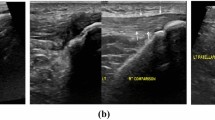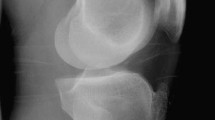Abstract
Introduction and objectives
Chronic groin pain (athletic pubalgia) is a common problem in sports such as football, hockey, cricket, baseball and athletics. Multiple co-existing pathologies are often present which commonly include posterior inguinal canal wall deficiency, conjoint tendinopathy, adductor tendinopathy, osteitis pubis and peripheral nerve entrapment. The mechanism of injury remains unclear but sports that involve either pivoting on a single leg (e.g. kicking) or a sudden change in direction at speed are most often associated with athletic pubalgia. These manoeuvres place large forces across the bony pelvis and its soft tissue supports, accounting for the usual clinical presentation of multiple symptomatic abnormalities forming one pattern of injury.
Results
The diagnoses encountered in this series of 100 patients included rectus abdominis muscle atrophy/asymmetry (22), conjoint tendinopathy (16), sports (occult, incipient) hernia (16), groin disruption injury (16), classical hernia (11) traumatic osteitis pubis (5), and avulsion fracture of the pubic bone (4). Surgical management was generally undertaken only after failed conservative therapy of 3–6 months, but some professionals who have physiotherapy during the football season went directly to surgery at the end of the football season. A variety of operations were performed including groin reconstruction (15), open hernia repair with or without mesh (11), sports hernia repair (Gilmore) (7) laparoscopic repair (3), conjoint tendon repair (3) and adductor tenotomy (3). Sixty-six patients were available for follow at an average of 13 years after initial consultation and the combined success rate for both conservative treatment and surgery was 94 %.
Conclusion
The authors believe that athletic pubalgia or sports hernia should be considered as a ‘groin disruption injury’, the result of functional instability of the pelvis. The surgical approach is aimed at strengthening the anterior pelvic soft tissues that support and stabilise the symphysis pubis.




Similar content being viewed by others
References
Orchard J, Read JW, Verall GM, Slavotinek JP (2000) Pathophysiology of chronic groin pain in the athlete. Int Sports Med J 1(1):1–20
Garvey JFW (2012) Computed tomography scan diagnosis of occult groin hernia. Hernia 16(3):307–314
Orchard J, Read JW, Neophyton J, Garlick D (1998) Groin pain associated with ultrasound finding of inguinal canal posterior wall deficiency in Australian Rules Footballers. Br J Sports Med 32(2):134–139
Schumpelick V, Treutner K, Arlt G (1994) Inguinal hernia repair in adults. Lancet 3(34):375–379
Boelens OBA, Scheltinga MR, Houterman S, Roumen RM (2013) Randomized clinical trial of trigger point infiltration with lidocaine to diagnose anterior cutaneous nerve entrapment syndrome. Br J Surg 100:217–221
Garvey JF, Read JW, Turner A (2010) Sportsman hernia: what can we do? Hernia 14(1):17–25
Garvey JF (2012) Sports hernia: controversies and scepticism. Aspetar Sports Med J 1:67–69
Orchard JW, Read JW, Anderson IF (2005) The use of diagnostic imaging in Sports Medicine. Med J Aust 183(9):482–488
Gilmore OJA (1998) Groin pain in the soccer athlete: fact, fiction and treatment. Clin Sports Med 17(4):787–793
Ekberg O, Persson NH, Abrahamsson PA, Westlin NE, Lilja B (1988) Longstanding groin pain in athletes and multidisciplinary approach. Sports Med 6(1):56–61
Lovell G (1995) The diagnosis of chronic pain in the athletes: a review of 189 cases. Aust J Sci Med Sport 27(3):76–79
Rochcongar P, Le Gall F, Jan J (1996) Pubalgie du sportif: mise au point a propos d’une etude retrospective de 214 patients (Pubic pain in athletes: a review and a retrospective study of 214 patients). Sci Sports (Paris) 11(3):135–139
Fredberg U, Kissmeyer-Nielsen P (1996) The Sportsman’s hernia—fact or fiction? Scand J Med Sci Sports 6(4):201–204
Malycha P, Lovell G (1992) Inguinal surgery in athletes with chronic groin pain: The “Sportsman’s” hernia. Aust N Z J Surg 62(2):123–125
Akermak C, Johanson C (1992) Tenotomy of the adductor longus tendon in the treatment of athletes. Am J Sports Med 20(6):640–643
Tuite DJ, Finegan PJ, Saliaris AP, Renstrom PA, Donne B, O’Brien M (1998) Anatomy of the proximal musculotendinous junction of the adductor longus muscle. Knee Surg Sports Traumatol Arthrosc 6(2):134–137
Wyley JJ (1983) Traumatic osteitis pubis: the gracilis syndrome. Am J Sports Med 11(5):360–363
Holt MA, Keene JS, Graff BK, Helwig DC (1995) Treatment of osteitis pubis in athletes: results of corticosteroid injections. Am J Sports Med 23(5):601–606
Bradshaw C, McCrory P, Bell S, Brukner P (1997) Obturator nerve entrapment. A cause of groin pain in athletes. Am J Sports Med 25(3):402–408
Gullmo A (1980) Herniorrhaphy: the diagnosis of hernia in the groin and incompetence of the pouch of Douglas and pelvic floor. Acta Radiol Suppl 361:1–76
Acknowledgement
Dr Michael T.W. Houang, Castlereagh Imaging Edgecliff—for performing CT scans Dr John W Read, Castlereagh Imaging St Leonards—for performing many of the ultrasounds and for providing the sonographs used in this article and review of the diagnostic imaging and the manuscript. Dr James Caristo—for Surgical Assistance. Ms Shauna McLean (B Soc Work)—for performing the long term follow-up Mrs Tracey Garvey (B Appl Sci)—for meticulous data collection and analysis.
Conflict of interest
None.
Author information
Authors and Affiliations
Corresponding author
Additional information
This research complies with the laws of the commonwealth of Australia.
Electronic supplementary material
Below is the link to the electronic supplementary material.
Rights and permissions
About this article
Cite this article
Garvey, J.F.W., Hazard, H. Sports hernia or groin disruption injury? Chronic athletic groin pain: a retrospective study of 100 patients with long-term follow-up. Hernia 18, 815–823 (2014). https://doi.org/10.1007/s10029-013-1161-0
Received:
Accepted:
Published:
Issue Date:
DOI: https://doi.org/10.1007/s10029-013-1161-0




